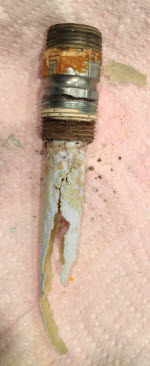From: Cheri Schuricht #213
 As our building ages, so do our appliances, including our hot water tanks. In fact, several RMC owners have already replaced refrigerators, dishwashers, and hot water tanks.I began noticing several water-related problems at my house: lack of water pressure in the kitchen due to the build-up of debris in the faucet, lots of debris in bathroom sink aerators that needed constant cleaning, and the lack of sufficient hot water for showers. I also wondered why it took the heater so long to get my house warm. Do any of these issues sound familiar to you? I decided to call a plumber when I had water in the cabinet under a sink, caused by debris clogging the flow of water. That’s when I found out the cause of my problem…I needed a new hot water tank.
As our building ages, so do our appliances, including our hot water tanks. In fact, several RMC owners have already replaced refrigerators, dishwashers, and hot water tanks.I began noticing several water-related problems at my house: lack of water pressure in the kitchen due to the build-up of debris in the faucet, lots of debris in bathroom sink aerators that needed constant cleaning, and the lack of sufficient hot water for showers. I also wondered why it took the heater so long to get my house warm. Do any of these issues sound familiar to you? I decided to call a plumber when I had water in the cabinet under a sink, caused by debris clogging the flow of water. That’s when I found out the cause of my problem…I needed a new hot water tank.
I have learned that inside every hot water tank is a 5-foot long plastic tube called the DIP TUBE.It brings in cold water from the bottom of the tank and forces warm water to the top of the tank, thus producing a warm house and hot showers.(That is the “in a nutshell” version. If you Google DIP TUBE, there is actually a video explanation.) My dip tube was no longer 5 feet long.It was 4 inches long! The missing 4 feet 8 inches of the dip tube had become debris filling my pipes, filters, and aerators!
A plumber from Fischer Plumbing replaced my hot water tank and flushed out my household plumbing. This included taking faucets apart, and checking filters on anything using hot water, like the washing machine and dishwasher. All of this work took several hours. Michael Wright, the Fischer plumber, said I could replace the dip tube in my original hot water tank, but it was not something he would recommend in a 10-year-old tank.
 I did some research on this deteriorating dip tube issue by speaking to a few experts: a representative from Bradford White, the maker of our tanks; a technician from Janes Infloor; and a plumber from Greenwood Hardware who installs many hot water tanks in Seattle. They all said I could have received a tank with a defective dip tube because these tubes should out-live the hot water tank. Our tanks are expected to last from 8 to 13 years, but can last longer. Because our tanks need to be kept at such a hot temperature setting to keep both domestic water and heating system working efficiently, it may mean our tanks will have a shorter life expectancy. There is a specialized dual tank available that provides separate water for heating and domestic usage, but it costs over $3000, according to Fischer Plumbing.
I did some research on this deteriorating dip tube issue by speaking to a few experts: a representative from Bradford White, the maker of our tanks; a technician from Janes Infloor; and a plumber from Greenwood Hardware who installs many hot water tanks in Seattle. They all said I could have received a tank with a defective dip tube because these tubes should out-live the hot water tank. Our tanks are expected to last from 8 to 13 years, but can last longer. Because our tanks need to be kept at such a hot temperature setting to keep both domestic water and heating system working efficiently, it may mean our tanks will have a shorter life expectancy. There is a specialized dual tank available that provides separate water for heating and domestic usage, but it costs over $3000, according to Fischer Plumbing.
My advice, especially if you are having water issues, is to check the aerators in the kitchens and bathroom sink faucets. If you are finding blue-colored plastic debris, the hot water heater may be your problem. Other RMC owners have discovered they have a similar problem.
More Information
http://www.diptube.info/
http://www.ronhazelton.com/tips/faulty_water_heater_dip_tube_-_diagnosis_and_replacement
